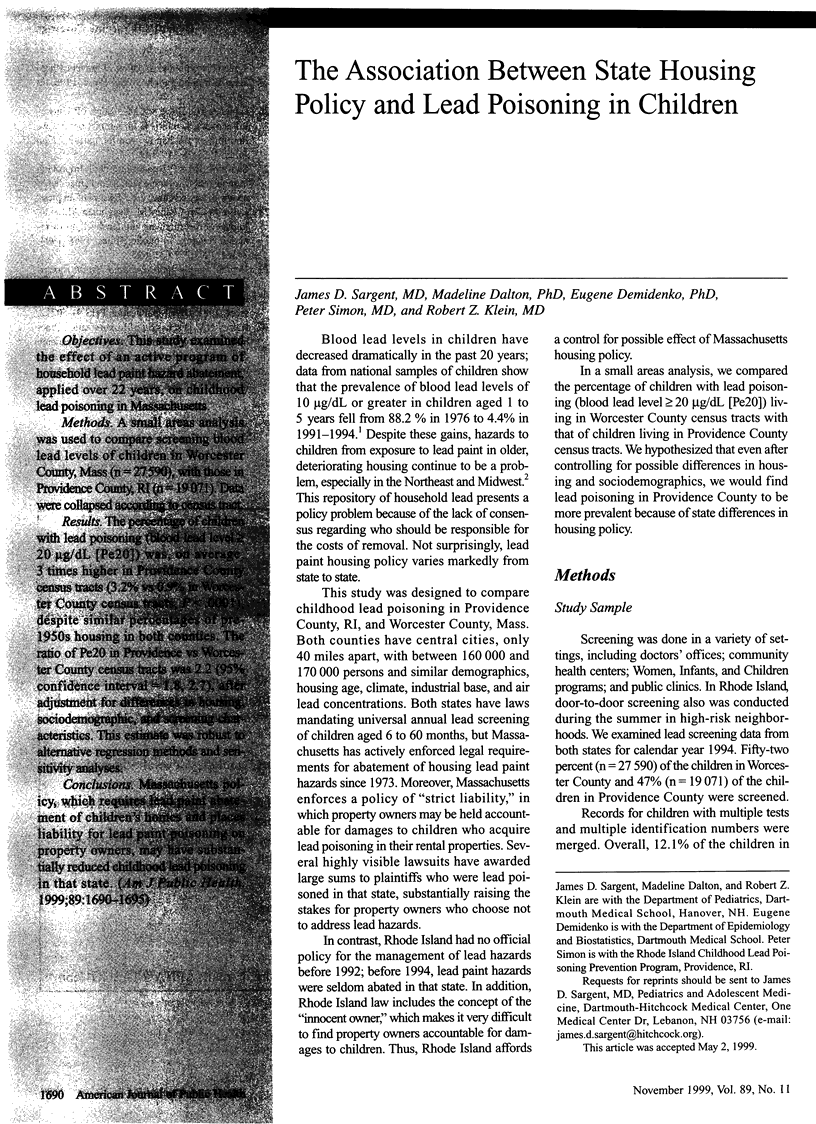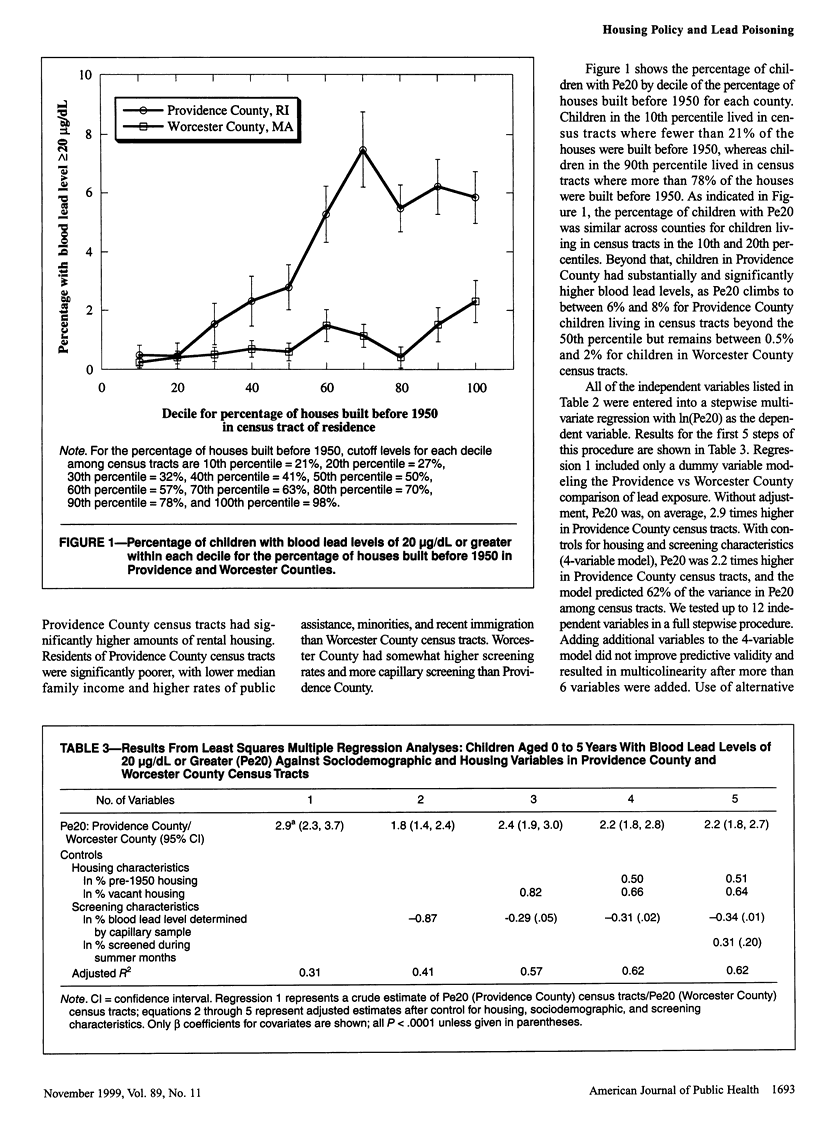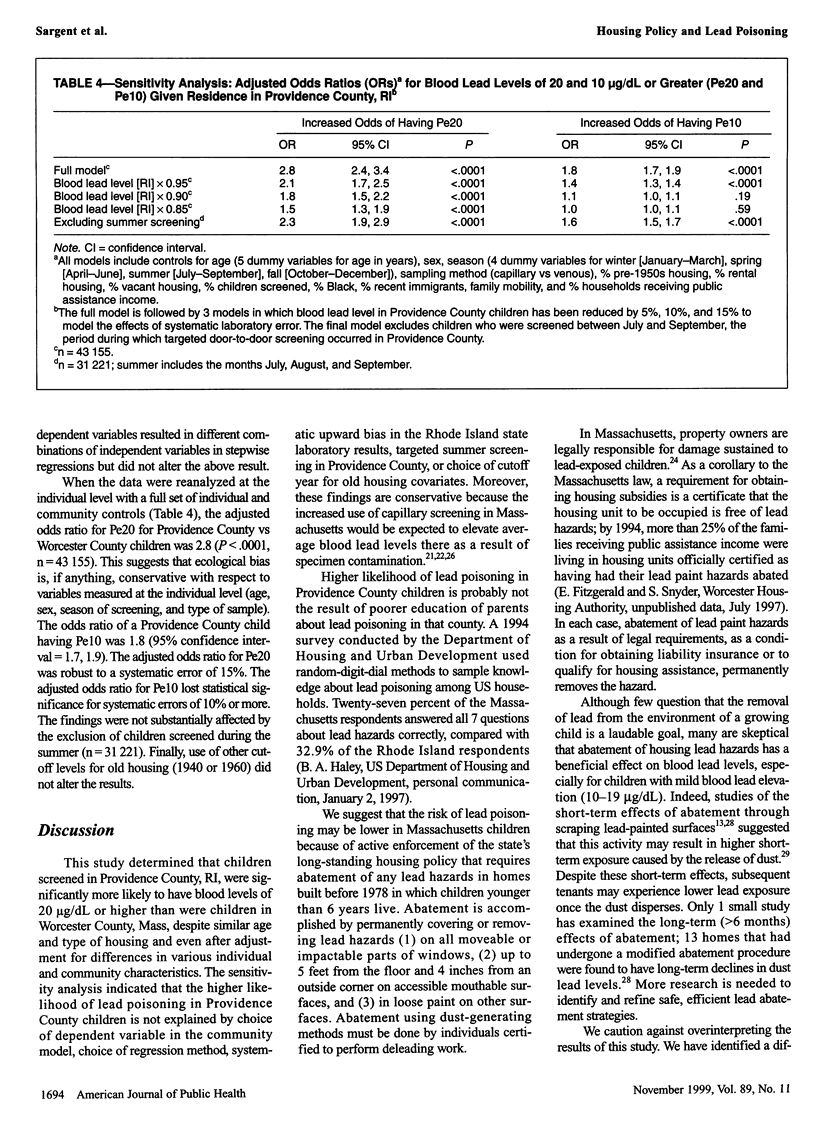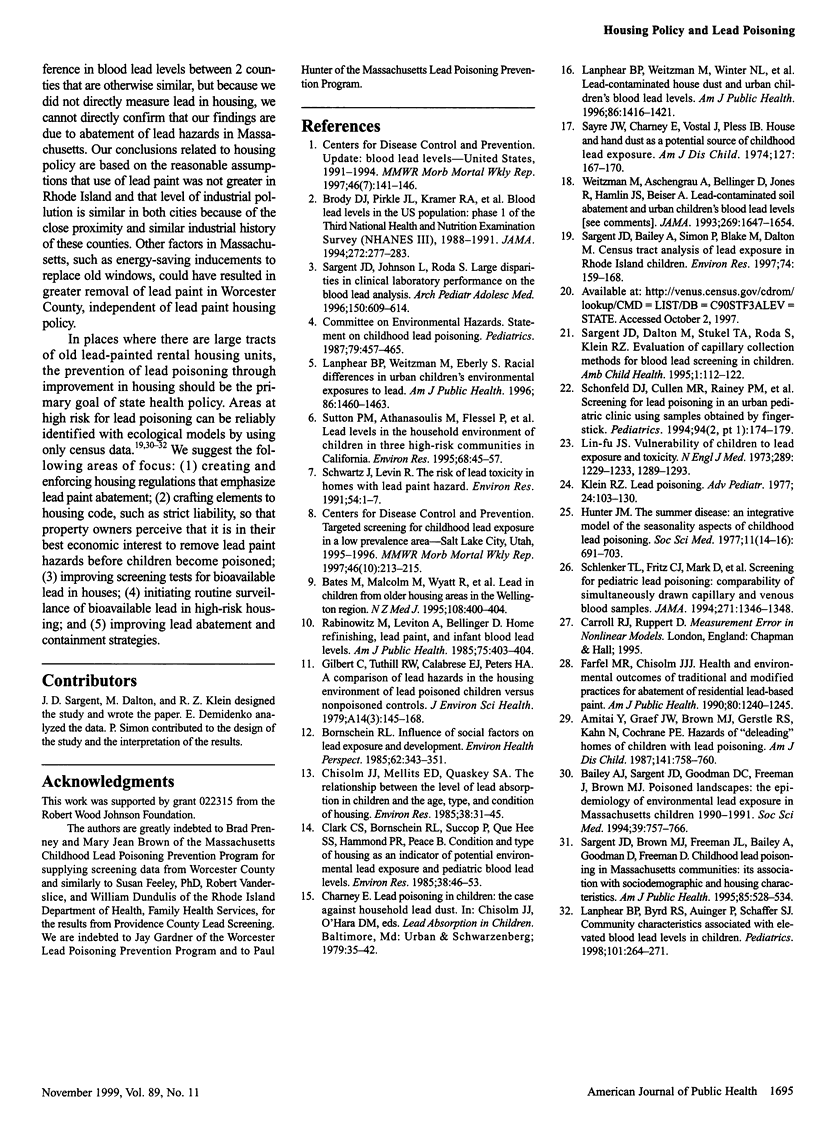Abstract
OBJECTIVES: This study examined the effect of an active program of household lead paint hazard abatement, applied over 22 years, on childhood lead poisoning in Massachusetts. METHODS: A small areas analysis was used to compare screening blood lead levels of children in Worcester County, Mass (n = 27,590), with those in Providence County, RI (n = 19,071). Data were collapsed according to census tract. RESULTS: The percentage of children with lead poisoning (blood lead level > or = 20 micrograms/dL [Pe20]) was, on average, 3 times higher in Providence County census tracts (3.2% vs 0.9% in Worcester County census tracts, P < .0001), despite similar percentages of pre-1950s housing in both counties. The ratio of Pe20 in Providence vs Worcester County census tracts was 2.2 (95% confidence interval = 1.8, 2.7), after adjustment for differences in housing, sociodemographic, and screening characteristics. This estimate was robust to alternative regression methods and sensitivity analyses. CONCLUSIONS: Massachusetts policy, which requires lead paint abatement of children's homes and places liability for lead paint poisoning on property owners, may have substantially reduced childhood lead poisoning in that state.
Full text
PDF





Selected References
These references are in PubMed. This may not be the complete list of references from this article.
- Amitai Y., Graef J. W., Brown M. J., Gerstle R. S., Kahn N., Cochrane P. E. Hazards of 'deleading' homes of children with lead poisoning. Am J Dis Child. 1987 Jul;141(7):758–760. doi: 10.1001/archpedi.1987.04460070060024. [DOI] [PubMed] [Google Scholar]
- Bailey A. J., Sargent J. D., Goodman D. C., Freeman J., Brown M. J. Poisoned landscapes: the epidemiology of environmental lead exposure in Massachusetts children 1990-1991. Soc Sci Med. 1994 Sep;39(6):757–766. doi: 10.1016/0277-9536(94)90037-x. [DOI] [PubMed] [Google Scholar]
- Bates M., Malcolm M., Wyatt R., Garrett N., Galloway Y., Speir T., Read D. Lead in children from older housing areas in the Wellington region. N Z Med J. 1995 Oct 13;108(1009):400–404. [PubMed] [Google Scholar]
- Bornschein R. L. Influence of social factors on lead exposure and child development. Environ Health Perspect. 1985 Oct;62:343–351. doi: 10.1289/ehp.8562343. [DOI] [PMC free article] [PubMed] [Google Scholar]
- Brody D. J., Pirkle J. L., Kramer R. A., Flegal K. M., Matte T. D., Gunter E. W., Paschal D. C. Blood lead levels in the US population. Phase 1 of the Third National Health and Nutrition Examination Survey (NHANES III, 1988 to 1991) JAMA. 1994 Jul 27;272(4):277–283. doi: 10.1001/jama.272.4.277. [DOI] [PubMed] [Google Scholar]
- Chisolm J. J., Jr, Mellits E. D., Quaskey S. A. The relationship between the level of lead absorption in children and the age, type, and condition of housing. Environ Res. 1985 Oct;38(1):31–45. doi: 10.1016/0013-9351(85)90070-2. [DOI] [PubMed] [Google Scholar]
- Clark C. S., Bornschein R. L., Succop P., Que Hee S. S., Hammond P. B., Peace B. Condition and type of housing as an indicator of potential environmental lead exposure and pediatric blood lead levels. Environ Res. 1985 Oct;38(1):46–53. doi: 10.1016/0013-9351(85)90071-4. [DOI] [PubMed] [Google Scholar]
- Farfel M. R., Chisolm J. J., Jr Health and environmental outcomes of traditional and modified practices for abatement of residential lead-based paint. Am J Public Health. 1990 Oct;80(10):1240–1245. doi: 10.2105/ajph.80.10.1240. [DOI] [PMC free article] [PubMed] [Google Scholar]
- Hunter J. M. The summer disease. An integrative model of the seasonality aspects of childhood lead poisoning. Soc Sci Med. 1977 Nov;11(14-16):691–703. doi: 10.1016/0037-7856(77)90155-x. [DOI] [PubMed] [Google Scholar]
- Klein R. Lead poisoning. Adv Pediatr. 1977;24:103–132. [PubMed] [Google Scholar]
- Lanphear B. P., Byrd R. S., Auinger P., Schaffer S. J. Community characteristics associated with elevated blood lead levels in children. Pediatrics. 1998 Feb;101(2):264–271. doi: 10.1542/peds.101.2.264. [DOI] [PubMed] [Google Scholar]
- Lanphear B. P., Weitzman M., Eberly S. Racial differences in Urban children's environmental exposures to lead. Am J Public Health. 1996 Oct;86(10):1460–1463. doi: 10.2105/ajph.86.10.1460. [DOI] [PMC free article] [PubMed] [Google Scholar]
- Lanphear B. P., Weitzman M., Winter N. L., Eberly S., Yakir B., Tanner M., Emond M., Matte T. D. Lead-contaminated house dust and urban children's blood lead levels. Am J Public Health. 1996 Oct;86(10):1416–1421. doi: 10.2105/ajph.86.10.1416. [DOI] [PMC free article] [PubMed] [Google Scholar]
- Lin-Fu J. S. Vulnerability of children to lead exposure and toxicity (second of two parts). N Engl J Med. 1973 Dec 13;289(24):1289–1293. doi: 10.1056/NEJM197312132892407. [DOI] [PubMed] [Google Scholar]
- Rabinowitz M., Leviton A., Bellinger D. Home refinishing, lead paint, and infant blood lead levels. Am J Public Health. 1985 Apr;75(4):403–404. doi: 10.2105/ajph.75.4.403. [DOI] [PMC free article] [PubMed] [Google Scholar]
- Sargent J. D., Bailey A., Simon P., Blake M., Dalton M. A. Census tract analysis of lead exposure in Rhode Island children. Environ Res. 1997;74(2):159–168. doi: 10.1006/enrs.1997.3755. [DOI] [PubMed] [Google Scholar]
- Sargent J. D., Brown M. J., Freeman J. L., Bailey A., Goodman D., Freeman D. H., Jr Childhood lead poisoning in Massachusetts communities: its association with sociodemographic and housing characteristics. Am J Public Health. 1995 Apr;85(4):528–534. doi: 10.2105/ajph.85.4.528. [DOI] [PMC free article] [PubMed] [Google Scholar]
- Sargent J. D., Johnson L., Roda S. Disparities in clinical laboratory performance for blood lead analysis. Arch Pediatr Adolesc Med. 1996 Jun;150(6):609–614. doi: 10.1001/archpedi.1996.02170310043008. [DOI] [PubMed] [Google Scholar]
- Sayre J. W., Charney E., Vostal J., Pless I. B. House and hand dust as a potential source of childhood lead exposure. Am J Dis Child. 1974 Feb;127(2):167–170. doi: 10.1001/archpedi.1974.02110210017002. [DOI] [PubMed] [Google Scholar]
- Schlenker T. L., Fritz C. J., Mark D., Layde M., Linke G., Murphy A., Matte T. Screening for pediatric lead poisoning. Comparability of simultaneously drawn capillary and venous blood samples. JAMA. 1994 May 4;271(17):1346–1348. doi: 10.1001/jama.271.17.1346. [DOI] [PubMed] [Google Scholar]
- Schonfeld D. J., Cullen M. R., Rainey P. M., Berg A. T., Brown D. R., Hogan J. C., Jr, Turk D. S., Rude C. S., Cicchetti D. V. Screening for lead poisoning in an urban pediatric clinic using samples obtained by fingerstick. Pediatrics. 1994 Aug;94(2 Pt 1):174–179. [PubMed] [Google Scholar]
- Schwartz J., Levin R. The risk of lead toxicity in homes with lead paint hazard. Environ Res. 1991 Feb;54(1):1–7. doi: 10.1016/s0013-9351(05)80189-6. [DOI] [PubMed] [Google Scholar]
- Sutton P. M., Athanasoulis M., Flessel P., Guirguis G., Haan M., Schlag R., Goldman L. R. Lead levels in the household environment of children in three high-risk communities in California. Environ Res. 1995 Jan;68(1):45–57. doi: 10.1006/enrs.1995.1007. [DOI] [PubMed] [Google Scholar]
- Weitzman M., Aschengrau A., Bellinger D., Jones R., Hamlin J. S., Beiser A. Lead-contaminated soil abatement and urban children's blood lead levels. JAMA. 1993 Apr 7;269(13):1647–1654. [PubMed] [Google Scholar]


